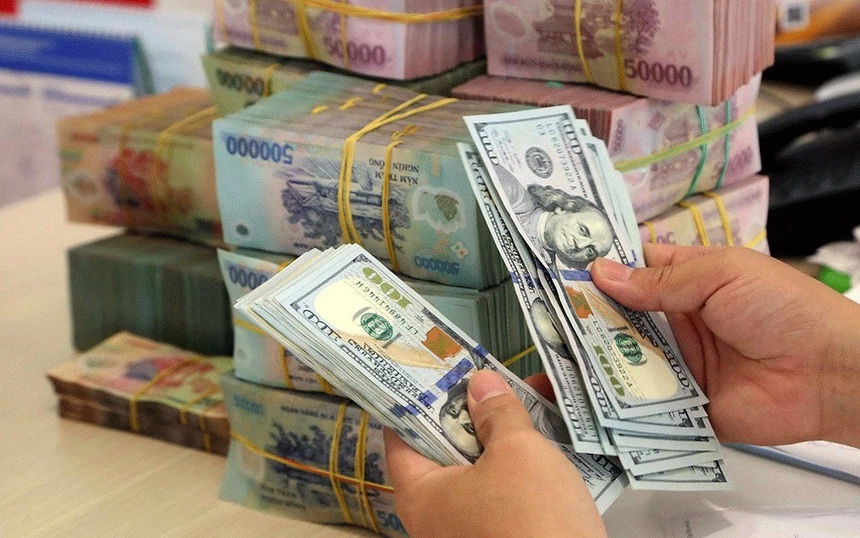Upward pressure on exchange rate by end-year
Stronger USD could contribute to a slight increase of 0.5-1% in USD/VND exchange rate in 4Q2021, said KB Securities.

Interbank USD/VND exchange rate has dropped dramatically since August when SBV adjusted down the rates for spot purchases.
The gap of exchange rates expanded
Interbank USD/VND exchange rate has dropped dramatically since August when the State Bank of Vietnam (SBV) adjusted down the rates for spot purchases. This happened after the US and Vietnam reached an agreement where Vietnam would not intentionally interfere in the market to depreciate VND. Besides, USD supply remained abundant thanks to the rebound of remittances, FDI and trade surplus in September. For the whole quarter, the USD/VND rates decreased by 1.04% to VND22,768 from VND23,008.
Meanwhile, unofficial rates slightly decreased in 3Q in line with the downtrend of the interbank rates, coming from: (1) The gap between domestic and international gold prices narrowed down (the gap remained at VND7 million/tael, a sharp decrease from VND9 million/tael in mid-August); (2) Restricted demand for USD trading in the wake of prolonged social distancing. USD/VND unofficial rates dropped by 0.8% to VND23,150 from 23,340 by the end of the third quarter.
The NEER and REER of VND increased in 3Q following stronger USD before and after the FOMC meeting when the Fed signaled that it would likely begin reducing monthly asset purchases as soon as November (provided that the economy would recover as expected) and the Dot plot showed that many Fed officials would be inclined to raise interest rates as soon as 2022 (9/18 vs. 7/18 at the meeting in June). However, the NEER and REER of VND remain low and are currently not the factors that put pressure on VND devaluation.
On August 11, the SBV announced a sharp reduction in the spot purchase prices of USD from VND22,975/USD to VND22,750/USD. KB Securities assessed this move would come from two main reasons. First, lowering the buying rate of USD is consistent with the exchange rate movements as well as USD supply-demand in the market. Second, after Vietnam and the US made positive progress in "currency manipulation", the SBV will be likely to actively return to using spot purchases to have immediate and effective impacts on the currency market, such as stabilizing exchange rates and interbank interest rates, supporting liquidity.

Interbank USD/VND exchange rate and unofficial rate have dropped since August 2021
Stronger USD
The USD supply is assessed to be stable in the last three months of 2021, thanks to the recovery of exports, FDI, and remittance inflows. Vietnam's 9M21 export turnover still reached USD240.5 million (18.8% YoY) and surpassed import turnover since the end of August, despite the negative impacts of the pandemic. With the manufacturing sector gradually recovering after the lockdown and the consumption demand increasing in many countries by the end of the year, KB Securities believed that Vietnamese businesses would continue to promote exports in the months to come to bring in more US dollars. Besides, 7M remittances of Ho Chi Minh City (accounting for 30% of the country's remittances) still posted a high level of USD3.7 billion (19% YoY) and is expected to continue to grow in the next months. The disbursement of FDI inflow is forecasted to rise after investors' confidence increases once the pandemic is under control.
Stronger USD contributed to a slight increase of 0.5-1% in USD/VND exchange rate in 4Q. However, KB Securities said this increase would be negligible thanks to the stable USD supply. In the third quarter alone, the US Dollar Index (DXY), which measures the strength of the dollar against the currency basket, increased by 1.9% QoQ to 94.23 points concentrating in the second half of September, before and after the FOMC meeting.
This uptrend will likely keep going on because KB Securities assessed that the Fed would maintain a more cautious monetary policy through reducing monthly asset purchases (QE tapering) and lifting interest rate due to (1) Increasing inflation risks when the personal consumption expenditures price index (PCEPI) of the US, a measure of prices used by the FOMC, escalated and exceeded its target at 2% for four consecutive months; (2) The ADP National Employment Report also showed that the monthly change in private nonfarm employment has picked up again since the severe decline at -20,236,000 in April 2020.








